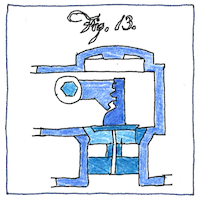James Watt
thermodynamics

|
Steam engine
James Watt didn’t invent the steam engine; he improved the Newcomen engine. Newcomen didn’t invent it either; Newcomen combined a vacuum, created by cooling steam, from Thomas Savery, with a piston from Denis Papin. The Newcomen engine rocked a beam up and down, suitable for operating a pump. Actually, the idea of harnessing steam is ancient. Archimedes invented a steam cannon in 212 BCE; Leonardo da Vinci invented another steam cannon around 1485, when it was called an architonnerre. Heron’s aeolipile, in 70 AD, was a simple steam turbine that did no work, but Gerbertus powered an organ with steam in 1125. More recently, Taqi al-Din invented a steam jack in 1551; Jerónimo de Ayanz y Beaumont a steam pump in 1606; Giovanni Branca a steam turbine in 1629; John Wilkins a steam jack in 1648; and Edward Somerset a water pump in 1663, which simply used steam-pressure to drive water up a pipe. To improve the Newcomen engine, Watt added a separate condensation chamber, injected steam into the upper part of the cylinder during the cooling cycle (called a “double acting” engine), and geared the engine for rotary motion.
Denis Papin
Denis Papin had collaborated with Christiaan Huygens on a piston-and-cylinder engine driven by exploding gunpowder. They gave up on that project, but it taught Papin about pistons. Working with Robert Boyle in 1680, Papin invented the safety valve and the first pressure cooker, which they called the “steam digester” because it was used for rendering fat and softening bones before grinding. Having learned from his steam digester, in 1690 Papin created a model steam engine that raised a weight from the condensation of steam. In 1704, Papin installed one of his engines in a ship to move its paddles. This was another first. And in 1705, working with Gottfried Leibniz and influenced by Thomas Savery, Papin developed an engine that used steam pressure rather than atmospheric pressure, yet another first!
Smeaton, too
John Smeaton created the equation for lift, with the coefficient of drag that the Wright brothers used and had to correct. Smeaton also improved the seals of the Newcomen steam engine and developed a theory of how a steam engine operates.
Why Watt?
Credit goes to James Watt for inventing the steam engine because using a separate condenser and harnessing both vacuum and pressure radically improved the efficiency of the steam engine, and his rotary gearing improved its usefulness. But all this wasn’t enough. Watt’s commercial success came about because Matthew Boulton became his business partner after Watt’s original partner, John Roebuck, defaulted. The practical and commercial success of the steam engine helped bring on the social and economic changes of the industrial revolution.
Heat engines
A steam engine is a heat engine. It converts heat into mechanical energy like an internal combustion engine or the earth’s atmosphere and hydrosphere. It would be tempting to say that life itself is also a heat engine, and many have argued one way or the other, which boils down to whether living things have free will or are merely driven by things they can’t control. I imagine Samuel Johnson arguing the matter by kicking a stone across a cobblestone street and asking, “Do I bounce like a stone?”



Atmospheric pressure was discovered in 1643 by Evangelista Torricelli, who invented the mercury barometer. Blaise Pascal was able to prove that the gap at the end of the barameter was a vacuum. Newcomen’s engine was called an atmospheric engine because it relied on atmospheric pressure against a vacuum created by cooling steam in a chamber. The Newcomen engine was not driven by steam pressure.
See also in The book of science:
Readings in wikipedia: